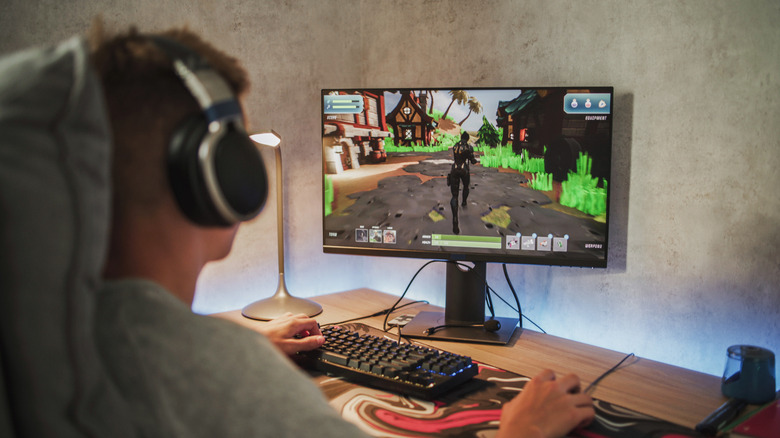Are 1080p Monitors Still Worth Buying For Gaming?
We may receive a commission on purchases made from links.
4K gaming is all the rage, and while 4K monitors have been easily available to consumers for what feels like forever, 1080p monitors still remain defiantly common. Ultra-high-definition displays may be eye candy, but they're often comparatively expensive. Moreover, plenty of new 1080p monitors have enthusiast gaming features like blisteringly high refresh rates, keeping them competitive with higher resolution panels. It's natural to wonder whether 1080p is still good enough for gaming in 2025.
The truth is that, while some gamers can benefit from higher resolutions, there are plenty of reasons why 1080p remains a fine choice for a vast number of players. Far from being a relic of yesteryear, 1080p — or full HD, aka FHD — remains the most common resolution for most media not produced by a major film or TV studio. It's also the most reliable rendering resolution for gamers playing new AAA titles on entry level or lower mid-tier gaming PCs.
However, there are still some valid reasons to seek out a monitor with a higher resolution like 1440p (2K, aka QHD) or 2160p (4K, aka UHD). Those who plan to use their monitors for content consumption outside of gaming, especially film and television viewing, will benefit massively from the ability to watch content at native resolutions, while those with top-tier and higher mid-tier gaming PCs will also benefit from crisper graphics while gaming. As one of SlashGear's resident PC gaming experts, I've spent a lot of time exploring how to optimize your gaming monitor. So, let's dive into all the reasons why 1080p monitors are still a great choice for some gamers in 2025, as well as why some may want to consider other options.
1080p is still a great option for many gamers
In 2025, 1080p gaming might seem quaint, but the majority of gaming PCs and consoles are still best optimized for it. According to the latest numbers from the April 2025 Steam Hardware Survey, the average gaming PC has an NVIDIA GeForce RTX 60-class card or lower in it. Variations of the GTX 1060 and RTX 2060, 3060, and 4060 occupy eight of the top 12 spots on the survey, with two of the remaining four taken up by even lower end cards. What all of those cards have in common is that they'll churn out the most frames per second when playing newer games at high graphics settings at a 1080p resolution.
In general, frame rates are far more important than resolution, and 1080p is the sweet spot for most gamers who want to get the best performance out of entry level graphics cards. A 1080p monitor with a high refresh rate, such as this Alienware 25 gaming monitor with a 360 hertz refresh rate, is a much better purchase than a 1440p or 4K monitor with a low refresh rate. You should also prioritize good connectivity and display panel technology over resolution. A great looking 1080p picture with accurate colors, good contrast, low latency and a high frame rate is always superior to a high-resolution picture that looks like garbage. By that same token, an OLED 1080p monitor could look better than an LCD 4K monitor in many instances, thanks to OLED's generally superior contrast and color. You should always compare spec sheets and look up trusted reviews for whichever monitor you end up considering and compare it to other options in your price range.
When to consider a high resolution monitor
The average gamer may not need a high resolution monitor, but you, dear reader, may not be average. If you have a high-end gaming PC with a more premium GPU like, for instance, an NVIDIA 70-class or higher and a beefy processor like the AMD Ryzen 7 9800X3D or similar alternatives, you will be better off with a monitor that supports resolutions of 1440p or higher. You can look up reviews of your graphics card to see what resolution professional hardware testers recommend. But, as a general rule, the past few generations of RTX 70-class cards are considered the best for 1440p, while the highest end cards like the 4090 and 5090 are considered best for full 4K gaming.
Even if your GPU's sweet spot is 1080p, it could be worth getting a 1440p monitor. Some games, especially if they're a few years old, will still perform well at 1440p on those graphics cards. Additionally, if your PC is also your TV, springing for a 4K display is probably wise. You'll have the option to watch movies, TV shows, and YouTube at native resolutions.
Those who plan to game on a current generation console using a monitor should also opt for 4K, if possible. Consoles like the upgraded PlayStation 5 Pro and the latest Xbox Series X are built around 4K gaming at high frame rates. Even the base model PlayStation 5 supports 4K in quality mode, though it drops frame rates to 60 FPS when quality mode is selected. If you're one of the many PS5 performance mode users who doesn't touch quality mode, you should still avoid 1080p — at least if you plan on streaming 4K video from the many streaming services available on your console.


